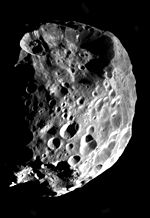User:Eurocommuter/test2

Ninety-three irregular satellites have been discovered since 1997 orbiting all four giant planets. Before 1997, only ten had been known, including Phoebe, the largest irregular satellite of Saturn, and Himalia, the largest irregular satellite of Jupiter. It is currently thought that the irregular satellites were captured from heliocentric orbits near their current locations, early after the formation of their parent planet. An altenative theory, that they orginated further out in the Kuiper Belt, is not supported by current observations.
Population overview
[edit]| planet | total | un- named |
pro grade |
retro grade |
|---|---|---|---|---|
| Jupiter | 53 | 14 | 7 | 46 |
| Saturn | 35 | 21 | 7 | 28 |
| Uranus | 9 | 0 | 1 | 8 |
| Neptune | 6 | 4 | 3 | 3 |
| Total | 103 | 39 | 18 | 85 |
(core facts)
- Most of the irregular satellites are retrograde (explained by the assymetry of thestability regions)
- Mention Sheppard (ca 100 smaller rocks...)
Mention obesrvational bias: outer planets' populations are expected to be richer than discovered so far.Divided into groups; each has a prominent member and a varying number of smaller onesGiven their distance and inclination, the orbits are highly perturbed by the Sun.Some of them are involved in complex secular and Kozai resonances.Their orbital elements change dramatically over short intervals. (Pasihae example: 1.5Gm in two years in a, 10 deg in inclination and 0.4 in eccentricity in 24 years; check figures; Carruba 2002!)- The interest of the irregulars
- Understanding of the origin of should proving insights into the early epoch of the solar system,
- Orbits as a memory of the planetary migration
- History rich in collisions (retro hitting progrades, example from Holman 2004)
Tisserand's relation
[edit]
Derivation
[edit]2007 NC7 The relation is derived from the Jacobi constant selecting a suitable unit system and some approximations. The relation is an approximate constant of motion for the (third) small mass μ3orbiting μ1 but which orbit have been modified b the second mass μ2.
These conditions are statisfied for example for the Sun - Jupiter system with a comet or a spacecraft being the third mass.
From the two-body (μ1,μ3) vis-viva equation
For the angular momentum h
the component is
where I is the inclination of μ3 orbit to μ2 orbit.
substituting these into the Jacobi constant
and taking μ2<<1 gives
except for small r2
Jacobi integral
[edit]
One of the suitable co-ordinates system used is so called synodic or co-rotating system. The line connecting the two masses is chosen as X axis, with the distant unit equal to their distance. The beginning of the system is the barycentre and the system co-rotates with m2, so the masses are stationary and positioned in (-μ2,0) and (0,-μ1).
In this co-ordinate system, the Jacobi constant is expressed as follows:
where:
are co-ordinates in the co-rotating system
mean motion
are the two masses
are distances of the test particle from the two masses
Derivation
[edit]In the co-rotating system, the accelerations can be expressed as derivatives of a single scalar function
[Eq.1]
[Eq.2]
[Eq.3]
Multiplying [Eq.1] , [Eq.2] and [Eq.3] par and respectively and adding all three yields
Integrating yields
where CJ is the constant of integration.
The left side represents the square of the velocity of the test particle in the co-rotating system.





















